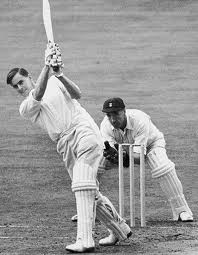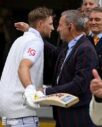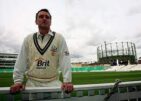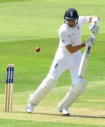Peter May: Enigma
Gareth Bland |
Even at the highest level of the game there are still some players who inspire awe among their team-mates. Both Rahul Dravid and Sachin Tendulkar were wont to simply sit back and enjoy VVS Laxman from a distance of 22 yards when they were batting in tandem. Geoffrey Boycott, even, once strolled down the wicket at the over’s end to tell David Gower “I wish I could bat like you”. The great left-hander also rendered the young Michael Atherton similarly awestruck during the 1990 England and India series, when, during Gower’s sumptuous 157 at The Oval, the 22 year-old opener had to pinch himself to believe that, yes, that really was his boyhood idol down the other end after all.
In the fourth Test of England’s 1958 home series against New Zealand the selectors decided to introduce three young fledglings to the team. Raymond Illingworth, Raman Subba Row and Ted Dexter were given their debuts in Manchester. The dashing 23 year old Sussex batsman, Dexter, would be given the chance to observe the national team captain and batting keystone, Peter May, at close quarters. May was England’s finest batsman and Dexter, like many before him and countless afterwards, watched with a mixture of wonder and technical admiration the commanding presence that was Peter Barker Howard May.
The combatants went into the Old Trafford Test that summer with England enjoying an unassailable 3-0 lead. The visitors chose to bat on winning the toss and their 267 was largely the result of a rearguard action mounted by MacGibbon, Sparling and Petrie, who contributed 66, 50 and 45 respectively. Earlier, only the great Bert Sutcliffe, with 41, demonstrated the nous required to thwart Trueman and Statham. In reply Richardson and Watson provided the soundest possible start with an opening stand of 126. When Watson was dismissed at 180-2 May came to the crease. Tom Graveney then fell with the score at 193-3 and, after a rally from May and debutant Subba Row, the fourth wicket fell at 248. Following a solid start, England’s innings entered a period of uncertainty. At Subba Row’s fall Dexter made his entrance.
The light at Old Trafford was not particularly welcoming and, in a match which suffered several interruptions for bad light and rain, it was clear that the batting side had to maximise its time out in the middle. Moreover, the moist air and cloud cover had delivered a playing surface on which, according to Wisden, “a bad hole had been worn on the pitch at the Stretford end in the region of the off stump to the left-handed batsman” and on which the bowlers “took divots out of the soft surface“. Not, then, the easiest circumstances in which to make a Test debut. From this potentially awkward position the England captain, May, reached into his box of tricks. Dexter recalls:
“I found myself batting with him in my first Test innings on a dank day at Old Trafford against New Zealand. Tony MacGibbon, Johnny Hayes and Bob Blair were big raw-boned pace bowlers, the pitch was damp, the light not good and the ball was moving about. Peter May played and missed a few times, and I certainly did. The situation was quite awkward.
I got the impression that he considered me to be something of a young scallywag, and he was probably right, but he offered me plenty of encouragement. He had been very kind and welcoming, as he always was, but I did not yet feel that I knew him very well. Suddenly he walked down the pitch and said, “There’s nothing for it, I think they’ve got to go”. The next thing I knew the ball was whistling over extra cover and to all parts as he simply took the attack apart”
“They’ve got to go”, delivered with characteristic understatement, presaged a violent assault on the Kiwi bowlers which meant May took the aerial route to the extent that he struck 4 sixes in addition to seven fours. His partnership with Dexter reorientated the England innings and the pair added 82. Dexter himself hit 6 fours and 2 sixes in his own 52 and England closed on 365 after the tail failed to wag.
It had been an exhibition of May’s essential duality: that of the quiet, dignified upper-middle class gent, combined with an aggression and sense of purpose – seldom evidenced off the field – that meant his team seized the initiative to winning effect. As Dexter observed, in dubbing his former captain “the enigmatic Peter May” the Surrey man “might have appeared to be the personification of the English gentleman, but that character became superseded by tigerish qualities when he took the field”.
As chairman of selectors himself a quarter of a century later, it was May, the quintessential English gentleman who manifested himself most often. During the darkest period of his reign, in the West Indies in 1986, the other May came to the surface, though. After losing the third Test and therefore the series, May ordered that greater resolve must be shown: “We have to grit our teeth” he opined. Derek Hodgson, writing during that 1986 tour, outlined the difference between May’s generation and that one led out on the field by David Gower:
“A devout family man, he comes of a generation of short back and sides, and polishing one’s own shoes. He even believes in the concept of duty”
The light mockery of May’s virtues juxtaposed with the imploding decadence of Gower’s troupe in early 1986, illustrates a fault line which ran through the domestic game during that period. It might be argued that today’s centrally contracted generation have managed to marry the ethos of “duty” as espoused by May, with the increasingly commercialised nature of the game itself. The backdrop to all that, of course, is societal change which has meant that few men of May’s caste are now represented in the running of the game. An increasingly managerial cadre have usurped the old governing class and fostered a “Team England” ethic which, oddly, has made the game less accessible than before, a result of its slavering devotion to television rights.
For the record, England went on to win the fourth Test in 1958 by an innings and complete a series whitewash. Peter May had vanquished more renowned foes than that year’s New Zealanders, of course. The year before, 1957, he famously tamed Sonny Ramadhin while compiling his epic 285 at Edgbaston, the highest score made by an England captain until Graham Gooch bested it in 1990. In three consecutive Ashes series – 1954/55, 1956 and 1958/59 – May topped the scoring for England. For the debutant Dexter, however, the 1958 Old Trafford match was his first sight, as a Test player himself, of the force that was PBH May from the unique vantage point of the opposite end.
Decades later that innings still evoked an immediacy of recall in Lord Ted which suggests the episode was akin to a formative experience. During May’s tenure as England captain, a remarkable 41 Tests, he averaged 54.03 with the bat. Moreover, for one thought to be a slave to convention, and despite his “gentleman” status as a player, May was not slow to acknowledge that the social divide between amateur and professional was an anachronism that had had its day.
As for Peter May’s stature in the game, that is not in doubt. Wisden waited until 1971 to pen its retirement tribute, in the vain hope that he would return to the fray and leave his business ventures at home. When it finally bowed to the inevitable, John Woodcock wrote:
“They knew him by his full name. Ask those who played with or against him between 1955 and 1960, or who watched him play, and they will tell you that Peter Barker Howard May was England’s finest post-war batsman”





I suppose a comeback in the 1960s was not out of the question, as many other amateurs did – notably Dexter, Sheppard and MJK Smith. Peter May was born on the same day as my dad and as a Surrey supporter too, not surprisingly was his favourite player. I think I’d still have him in my Post-War England XI despite the superior aggregates of Pietersen and others.
Comment by stumpski | 12:00am BST 16 August 2013